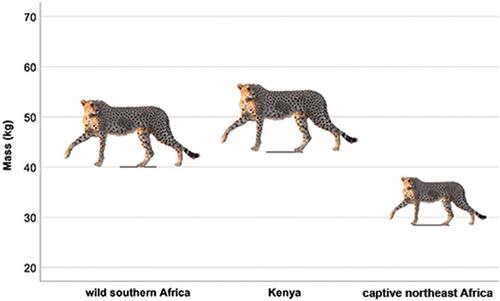Our official English website, www.x-mol.net, welcomes your
feedback! (Note: you will need to create a separate account there.)
Regional variation in the cheetah ( Acinonyx jubatus ) revisited: Morphology of wild and captive populations
Zoo Biology ( IF 1.2 ) Pub Date : 2020-03-01 , DOI: 10.1002/zoo.21523 Julie Meachen 1 , Anne Schmidt-Küntzel 2 , Laurie Marker 2
Zoo Biology ( IF 1.2 ) Pub Date : 2020-03-01 , DOI: 10.1002/zoo.21523 Julie Meachen 1 , Anne Schmidt-Küntzel 2 , Laurie Marker 2
Affiliation

|
The cheetah (Acinonyx jubatus) is listed as a vulnerable species by the International union for the conservation of nature (IUCN), including two critically endangered subspecies, the Saharan cheetah, and the Iranian cheetah, so it is imperative that we understand variation in cheetah morphology to make good decisions regarding the conservation of this species. Here, we aim to determine whether northeastern African cheetahs have smaller body sizes than southern African cheetahs. This study also adds to our knowledge of cheetah morphology from two cheetah populations that do not yet have comprehensive published data: Kenya, and northeastern Africa, including captive individuals. We calculated means and standard deviations on cranial and body measurements of live or in few cases, freshly dead, cheetahs from the aforementioned populations, plus previously published data on Namibian and Botswanan cheetahs and compared them to one another using multivariate analysis of variance. Results show that northeastern African cheetahs have smaller body sizes than southern and eastern African populations. We also found that captive cheetahs retain the morphological characteristics of their ancestral population- captive cheetahs from southern Africa have similar body sizes to wild southern African cheetahs and larger body sizes than captives from northeastern Africa. Other analyses regarding cheetah growth agree with previous studies on Namibian and Botswanan cheetah populations rates. As such, this study can serve as a baseline for the care of captive cheetah populations to maintain healthy weights and body proportions.
中文翻译:

重新审视猎豹( Acinonyx jubatus )的区域变异:野生和圈养种群的形态学
猎豹(Acinonyx jubatus)被国际自然保护联盟(IUCN)列为易危物种,包括两个极度濒危的亚种撒哈拉猎豹和伊朗猎豹,因此我们必须了解猎豹的变异形态学以做出关于保护该物种的正确决定。在这里,我们的目标是确定东北部非洲猎豹的体型是否比南部非洲猎豹小。这项研究还增加了我们对尚未获得全面公开数据的两个猎豹种群的猎豹形态的了解:肯尼亚和非洲东北部,包括圈养个体。我们计算了来自上述种群的活的或在少数情况下刚死的猎豹的颅骨和身体测量值的平均值和标准差,加上先前发布的关于纳米比亚和博茨瓦纳猎豹的数据,并使用多变量方差分析将它们相互比较。结果表明,东北部非洲猎豹的体型比南部和东部非洲种群小。我们还发现圈养猎豹保留了其祖先种群的形态特征——来自南部非洲的圈养猎豹与野生南部非洲猎豹的体型相似,而体型比来自非洲东北部的圈养猎豹更大。关于猎豹生长的其他分析与之前对纳米比亚和博茨瓦纳猎豹种群比率的研究一致。因此,这项研究可以作为照顾圈养猎豹种群以保持健康体重和身体比例的基线。
更新日期:2020-03-01
中文翻译:

重新审视猎豹( Acinonyx jubatus )的区域变异:野生和圈养种群的形态学
猎豹(Acinonyx jubatus)被国际自然保护联盟(IUCN)列为易危物种,包括两个极度濒危的亚种撒哈拉猎豹和伊朗猎豹,因此我们必须了解猎豹的变异形态学以做出关于保护该物种的正确决定。在这里,我们的目标是确定东北部非洲猎豹的体型是否比南部非洲猎豹小。这项研究还增加了我们对尚未获得全面公开数据的两个猎豹种群的猎豹形态的了解:肯尼亚和非洲东北部,包括圈养个体。我们计算了来自上述种群的活的或在少数情况下刚死的猎豹的颅骨和身体测量值的平均值和标准差,加上先前发布的关于纳米比亚和博茨瓦纳猎豹的数据,并使用多变量方差分析将它们相互比较。结果表明,东北部非洲猎豹的体型比南部和东部非洲种群小。我们还发现圈养猎豹保留了其祖先种群的形态特征——来自南部非洲的圈养猎豹与野生南部非洲猎豹的体型相似,而体型比来自非洲东北部的圈养猎豹更大。关于猎豹生长的其他分析与之前对纳米比亚和博茨瓦纳猎豹种群比率的研究一致。因此,这项研究可以作为照顾圈养猎豹种群以保持健康体重和身体比例的基线。











































 京公网安备 11010802027423号
京公网安备 11010802027423号